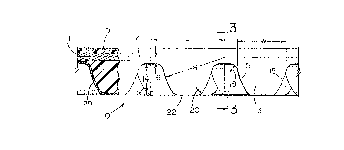Une partie des informations de ce site Web a été fournie par des sources externes. Le gouvernement du Canada n'assume aucune responsabilité concernant la précision, l'actualité ou la fiabilité des informations fournies par les sources externes. Les utilisateurs qui désirent employer cette information devraient consulter directement la source des informations. Le contenu fourni par les sources externes n'est pas assujetti aux exigences sur les langues officielles, la protection des renseignements personnels et l'accessibilité.
L'apparition de différences dans le texte et l'image des Revendications et de l'Abrégé dépend du moment auquel le document est publié. Les textes des Revendications et de l'Abrégé sont affichés :
| (12) Brevet: | (11) CA 2075863 |
|---|---|
| (54) Titre français: | COURROIE D'ENTRAINEMENT SYNCHRONE A DENTS OBLIQUES ET DECALEES |
| (54) Titre anglais: | SYNCHRONOUS DRIVE BELT WITH OBLIQUE AND OFFSET TEETH |
| Statut: | Durée expirée - au-delà du délai suivant l'octroi |
| (51) Classification internationale des brevets (CIB): |
|
|---|---|
| (72) Inventeurs : |
|
| (73) Titulaires : |
|
| (71) Demandeurs : | |
| (74) Agent: | MARKS & CLERK |
| (74) Co-agent: | |
| (45) Délivré: | 1998-09-15 |
| (22) Date de dépôt: | 1992-08-12 |
| (41) Mise à la disponibilité du public: | 1993-11-30 |
| Requête d'examen: | 1993-07-12 |
| Licence disponible: | S.O. |
| Cédé au domaine public: | S.O. |
| (25) Langue des documents déposés: | Anglais |
| Traité de coopération en matière de brevets (PCT): | Non |
|---|
| (30) Données de priorité de la demande: | ||||||
|---|---|---|---|---|---|---|
|
Courroie d'entraînement synchrone présentant au moins deux rangées adjacentes de dents qui sont disposées à angles obliques équilibrés opposés au sens longitudinal de la courroie. De plus, les axes centraux des dents des rangées adjacentes sont décalés les uns par rapport aux autres d'une distance allant de 10 à 90 % de leur inclinaison.
A synchronous drive belt has at least two
adjacent rows of teeth which are at oppositely
balanced oblique angles to the longitudinal direction
of the belt. In addition, the centerlines of the
teeth in the adjacent rows are offset from each other
by a distance of up to 10% to 90% of their pitch.
Note : Les revendications sont présentées dans la langue officielle dans laquelle elles ont été soumises.
Note : Les descriptions sont présentées dans la langue officielle dans laquelle elles ont été soumises.

2024-08-01 : Dans le cadre de la transition vers les Brevets de nouvelle génération (BNG), la base de données sur les brevets canadiens (BDBC) contient désormais un Historique d'événement plus détaillé, qui reproduit le Journal des événements de notre nouvelle solution interne.
Veuillez noter que les événements débutant par « Inactive : » se réfèrent à des événements qui ne sont plus utilisés dans notre nouvelle solution interne.
Pour une meilleure compréhension de l'état de la demande ou brevet qui figure sur cette page, la rubrique Mise en garde , et les descriptions de Brevet , Historique d'événement , Taxes périodiques et Historique des paiements devraient être consultées.
| Description | Date |
|---|---|
| Inactive : Périmé (brevet - nouvelle loi) | 2012-08-12 |
| Lettre envoyée | 2009-06-26 |
| Inactive : CIB de MCD | 2006-03-11 |
| Accordé par délivrance | 1998-09-15 |
| Inactive : Taxe finale reçue | 1998-05-11 |
| Préoctroi | 1998-05-11 |
| Un avis d'acceptation est envoyé | 1997-11-19 |
| Un avis d'acceptation est envoyé | 1997-11-19 |
| Lettre envoyée | 1997-11-19 |
| Inactive : Dem. traitée sur TS dès date d'ent. journal | 1997-11-13 |
| Inactive : Renseign. sur l'état - Complets dès date d'ent. journ. | 1997-11-13 |
| Inactive : CIB en 1re position | 1997-11-05 |
| Inactive : CIB enlevée | 1997-11-05 |
| Inactive : CIB attribuée | 1997-11-05 |
| Inactive : Approuvée aux fins d'acceptation (AFA) | 1997-11-05 |
| Demande publiée (accessible au public) | 1993-11-30 |
| Toutes les exigences pour l'examen - jugée conforme | 1993-07-12 |
| Exigences pour une requête d'examen - jugée conforme | 1993-07-12 |
Il n'y a pas d'historique d'abandonnement
Le dernier paiement a été reçu le
Avis : Si le paiement en totalité n'a pas été reçu au plus tard à la date indiquée, une taxe supplémentaire peut être imposée, soit une des taxes suivantes :
Veuillez vous référer à la page web des taxes sur les brevets de l'OPIC pour voir tous les montants actuels des taxes.
Les titulaires actuels et antérieures au dossier sont affichés en ordre alphabétique.
| Titulaires actuels au dossier |
|---|
| VEYANCE TECHNOLOGIES, INC. |
| Titulaires antérieures au dossier |
|---|
| MICHAEL J. W. GREGG |